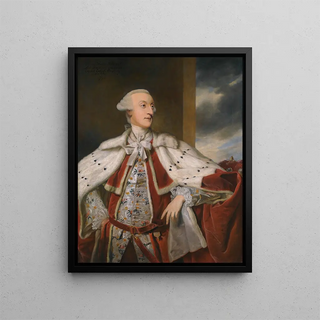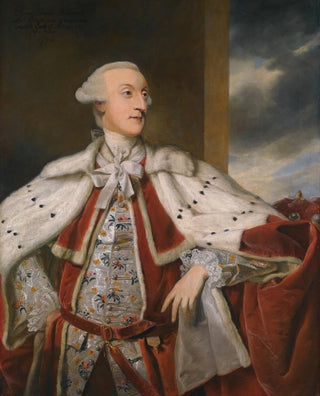Art print | Portrait of Thomas Bruce Brudenell Bruce, later 1st Earl of Ailesbury - Sir Joshua Reynolds


View from behind

Frame (optional)
In the vast panorama of 18th-century British art, Sir Joshua Reynolds's work stands out for its elegance and technical mastery. The "Portrait of Thomas Bruce Brudenell Bruce, later 1st Earl of Ailesbury" perfectly embodies this refined aesthetic. This painting, which reflects a time when portraiture was not only a means of representation but also a tool of social status, invites us to delve into the aristocratic universe of old England. Through this art print, we have the opportunity to explore not only the features of the model but also the subtleties of portrait art, revealing social interactions and power dynamics that prevailed at the time.
Style and uniqueness of the work
Reynolds's style is characterized by a blend of realism and idealization. In this portrait, the treatment of colors and textures demonstrates a meticulous search for light and shadow, creating a depth effect that brings the subject to life. The face of Thomas Bruce Brudenell Bruce is illuminated in a way that emphasizes his nobility, while the drapery of his costume is rendered with such finesse that it almost feels tangible. This attention to detail, combined with a harmonious composition, allows the viewer to feel the personality of the Earl of Ailesbury, while placing him within a rich historical context. The choice of accessories and background elements also enhances the prestigious character of the representation, making this work a true testament to the aristocratic identity of its era.
The artist and his influence
Sir Joshua Reynolds, an iconic figure of portraiture, made his mark through an innovative approach. As the first president of the Royal Academy of Arts, he played a crucial role in establishing artistic standards that still endure today. His influence extends beyond his technical skill; he also introduced narrative and psychological themes into his portraits, inviting the viewer to a deeper contemplation. Reynolds was able to capture not only the physical appearance of his models but also their essence, their character. This ability to transcend mere visual rendering...

Matte finish

View from behind

Frame (optional)
In the vast panorama of 18th-century British art, Sir Joshua Reynolds's work stands out for its elegance and technical mastery. The "Portrait of Thomas Bruce Brudenell Bruce, later 1st Earl of Ailesbury" perfectly embodies this refined aesthetic. This painting, which reflects a time when portraiture was not only a means of representation but also a tool of social status, invites us to delve into the aristocratic universe of old England. Through this art print, we have the opportunity to explore not only the features of the model but also the subtleties of portrait art, revealing social interactions and power dynamics that prevailed at the time.
Style and uniqueness of the work
Reynolds's style is characterized by a blend of realism and idealization. In this portrait, the treatment of colors and textures demonstrates a meticulous search for light and shadow, creating a depth effect that brings the subject to life. The face of Thomas Bruce Brudenell Bruce is illuminated in a way that emphasizes his nobility, while the drapery of his costume is rendered with such finesse that it almost feels tangible. This attention to detail, combined with a harmonious composition, allows the viewer to feel the personality of the Earl of Ailesbury, while placing him within a rich historical context. The choice of accessories and background elements also enhances the prestigious character of the representation, making this work a true testament to the aristocratic identity of its era.
The artist and his influence
Sir Joshua Reynolds, an iconic figure of portraiture, made his mark through an innovative approach. As the first president of the Royal Academy of Arts, he played a crucial role in establishing artistic standards that still endure today. His influence extends beyond his technical skill; he also introduced narrative and psychological themes into his portraits, inviting the viewer to a deeper contemplation. Reynolds was able to capture not only the physical appearance of his models but also their essence, their character. This ability to transcend mere visual rendering...






